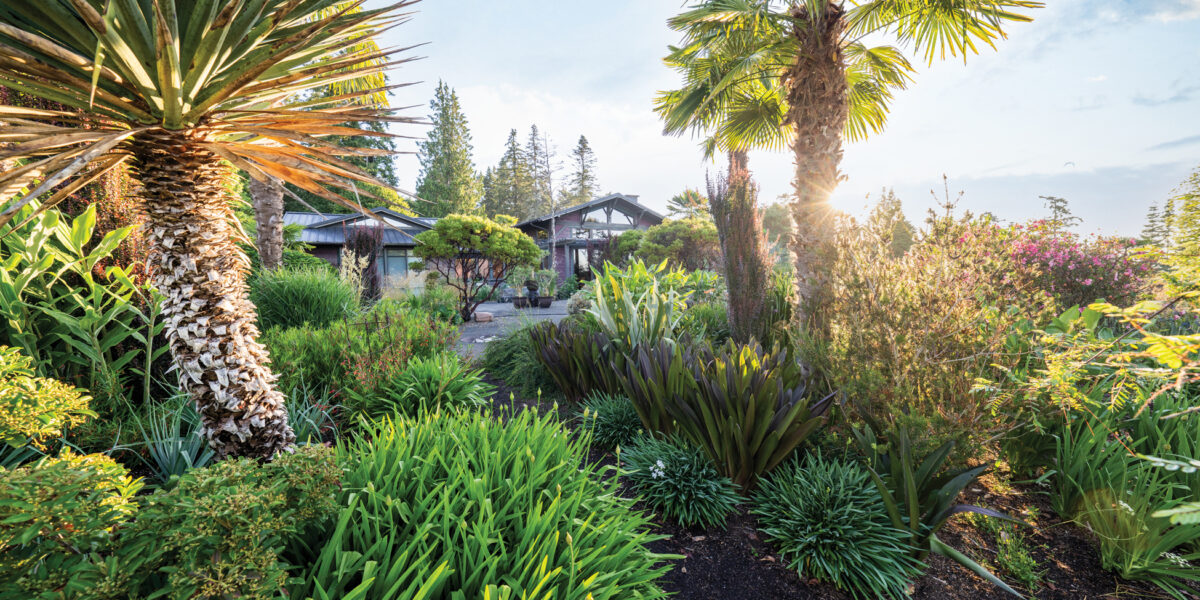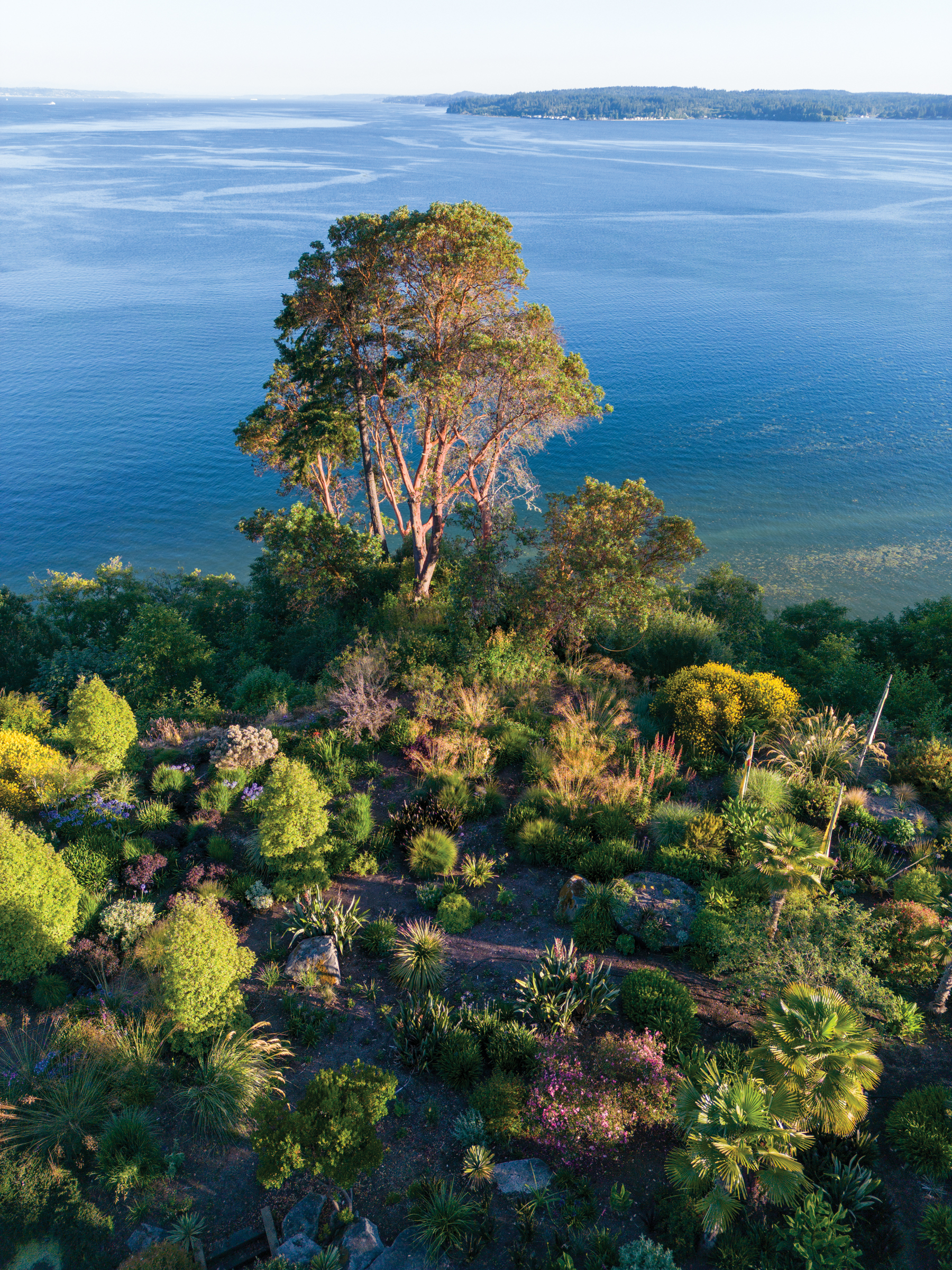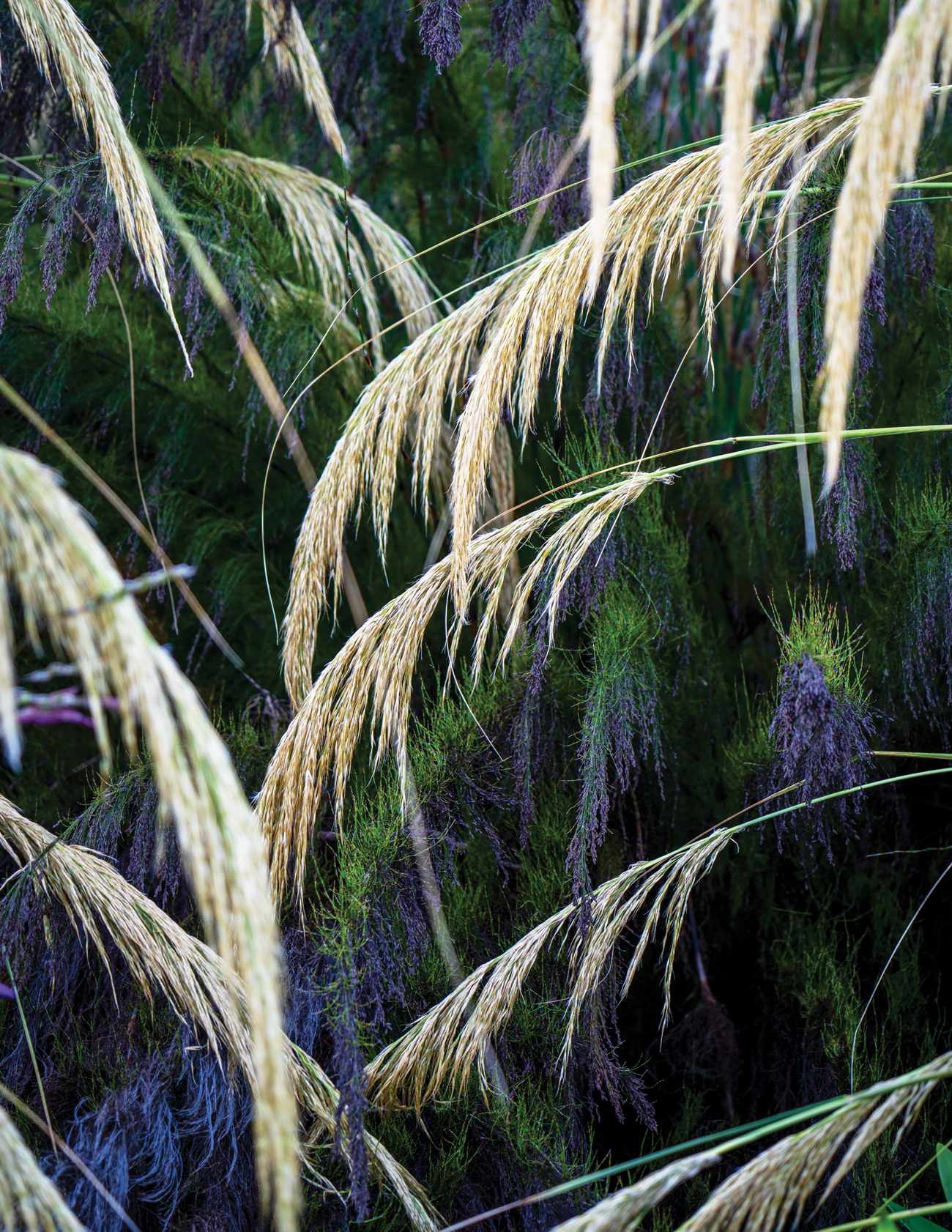
This Professional Plant Hunter’s Garden Is as Amazing as You’d Expect
Daniel J. Hinkley’s iconic garden, Windcliff, is a map of his adventures as a plant hunter and a life well lived.

When I think of a plant hunter—as in, someone who goes to places like South Africa, Vietnam, China, and Nepal to find rare species and bring them back to the United States—I imagine a swashbuckling Indiana Jones type running through the mountains complete with hat and whip. And to hear famed plant collector, horticulturist, and botanist Daniel Hinkley tell it, there is a bit of daredevilry to the job. “I’ve had hard treks, bad knees, bee stings, and leeches hanging from my neck,” he says. “But if I am lucky, plant collecting offers me a bit of seed, and the resulting plant possesses all of the memories associated with it.”

Thomas J. Story
When he’s not covered in leeches, Hinkley can be found in his famed garden, Windcliff, in Indianola, Washington, which extends across six-and-a-half acres on a south-facing bluff high above Puget Sound. It is a garden of astonishing beauty—the culmination of a plant man’s incomparable eye and vast expertise on how to nurture living things.
Hinkley fell in love with plants at the age of five. He remembers his first time sowing seeds of morning glories and gourds with his father, and although he can’t explain what exactly the attraction was, he soon promoted himself to head vegetable gardener. This in a family that grew up during the Great Depression and, frankly, didn’t understand why he couldn’t just buy canned beans if he wanted them so much. By high school, Hinkley was collecting houseplants and orchids while studying what grew around him in Northern Michigan. Multiple degrees in horticulture soon followed.

Thomas J. Story

Thomas J. Story
In the late eighties Hinkley opened the world-renowned garden and nursery, Heronswood, in Kingston, Washington, with his then-partner, now-husband, Robert L. Jones. This is when Hinkley began to make his mark. Eager to showcase rare finds—and to follow in the footsteps of his Victorian plant-hunting heroes, George Forrest and E.H. Wilson—he took three months off to search for plants in South Korea. He says he did it because he was drawn to do it, and soon found plant hunting came naturally to him. “I’ve always had that travel bug, so travel and looking at plants was a given for me,” Hinkley says. “It always astounded me that I could be anywhere in the world and people could come up to me and say, ‘What is there to do around here?’ And I’d be like, ‘What are you talking about? Look at the forest that’s all around.’” He says he still feels that anywhere he goes he has entertainment—all he has to do is look out the window and stare at the plants.

Thomas J. Story

Thomas J. Story
When I first communicated with Hinkley, it had to be over email because he was plant hunting in Vietnam on two surgically replaced knees that “got him up the mountains.” I told him it’s hard to imagine how one could procure the seeds of an undiscovered plant from the midst of an entire jungle, but Hinkley says it’s not exactly like that. He has an idea of where to look; usually it’s a place that’s least explored. In this case, he was in an area that was only recently opened to botanists because it was heavily mined during the Vietnam war. There he found a brand-new species of loropetalum (evergreens related to witch hazels) and magnolia—discoveries that, he says, “thrilled him.”

Thomas J. Story

Thomas J. Story
Ninety-nine percent of what Hinkley does happens after he’s collected the seeds of what he suspects is a “new” plant. (I use quotation marks, because, as he points out, the plants are already known to the people who live in the area—they’re just new to us in the West.) First, Hinkley gets the seeds to the USDA. Then, if approved, he has to germinate them, and then he has to bring them to flower, which could take 20 years if it’s a tree. Finally, he needs to find an expert in the genus to look at the plant, confirm that it as an interesting prospect, and send a sample to yet another expert, usually at a university. Only with careful confirmation can he declare he’s found a plant that’s “new to us.”

Thomas J. Story
Which brings us to Windcliff, the personal garden Hinkley started when he sold Heronswood over two decades ago. All around the property are specimens that Hinkley collected over decades of plant-hunting adventures, from giant-leaved Gunnera tinctoria, which he found in Chile in 1998, to Geranium x oxonianum ‘Katherine Adele’, a hearty and pink-petaled plant that he named for his husband’s mother. Geographically speaking, the garden is carefully arranged, but in a casual way. (This isn’t the gardens at the Palace of Versailles, Dieu merci.) To the north is woodland, a meadow, and an arboretum; to the south one can find a pond, a bog, terraces, Hinkley’s beloved vegetable garden, waves of violet agapanthus, and a heavily planted bluff with enormous fir trees that frame the sea. It’s a place positively packed with plants and a living laboratory of sorts, since Hinkley plants his finds in the garden to see how they do.

Thomas J. Story
To create Windcliff, Hinkley commissioned a “council ring” by mosaic artist Jeffrey Bayle, which acts as the heart of the garden, a place where friends gather for fireside chats. He then tackled a third of an acre at a time. Jones, who is an architect, created the terraces and designed the house, while Hinkley relied on his mind’s eye for plant placement, rather than mapping everything out. When designing a garden, he considers textural differences in foliage, height differences, fragrance, seasonality, and overall balance. He also isn’t afraid to go against conventional wisdom, like when he decided to interrupt the expansive view of Puget Sound with plants. “If one has to work a bit for a beautiful view, it makes it more beautiful,” Hinkley says. “I do not feel it is necessary to sit in a BarcaLounger and survey my entire property.”

Thomas J. Story
Surprisingly, Hinkley doesn’t employ a large staff to maintain the garden; he does it himself with the help of his employee of nine years, Eduardo Montes. To finance the maintenance, Hinkley sells plants out of his nursery, which can only be shopped in person. The online catalogue is worth a read. Of Acer griseum, a tree of wild origin, Hinkley writes that it’s so beautiful “you should plant it for yourself and your children.” Agapanthus ‘Jamaica Kincaid’, meanwhile, flowers with “a blue somewhat deeper in color than the perfectly blue skies you once remembered a long time ago.” Fortunately, although plants can’t be shipped, visitors can see the garden and shop the nursery at Windcliff three days a week by appointment.

Thomas J. Story
Although I still can’t help but imagine plant hunters as hacking through acid-green jungles to chop down large plant stalks by racing rivers, I have been convinced that it is, in fact, not quite so cinematic. Hinkley looks for plants not in spring but in the fall, when they have gone to seed. “I feel at age 70 the number of autumns I’m going to get to do is starting to diminish, but I still want to do it,” Hinkley says. “Even though I can be completely exhausted by the garden and by propagating, the next day I’m in it again. The fuel cells never stop pumping.”
Plant Daniel J. Hinkley’s Discoveries in Your Own Backyard
Plantsman Hinkley has been lauded by one prestigious horticulture organization after another, and is something of a rock star on the botanical lecture circuit. Martha Stewart calls him a “horticulturist extraordinaire.” Meanwhile, Jonathan Pedersen, CEO of plant grower Monrovia, says, “There are plant hunters, and then there is Dan Hinkley. His importance to the world of gardening cannot be overstated.”
Perhaps because he is a famous plant hunter, Hinkley is careful to point out that his expeditions are entirely aboveboard. “When many people hear what I do, their immediate assumption is that I smuggle seeds back in my suitcase,” he says. However, he has all the necessary permits to bring seeds or plants out of a country and into the U.S., and he avoids plants that are bio-invasive with help from the University of Washington. Here, six of Hinkley’s discoveries that you can buy from Monrovia’s Dan Hinkley Collection.
Read the Current Issue Here!
Get one year of Sunset—and all kinds of bonuses—for just $24.95. Subscribe now!
